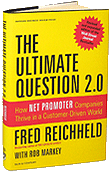
In my previous three articles we have explored the indicator of the net promoter score, and the possible uses of this indicator to improve the satisfaction of your customers. In this article I will bring you some thoughts on the nature of the profits made by your company.
One notion raised in The Ultimate Question 2.0 is that of good and bad profit.
The goal of any organization is to generate profits. Fred Reichheld questions the nature of these profits and classifies them into two categories: good and bad. According to him a bad profit is a profit that generates detractors. The results of the company do not reflect the nature of the profits. But bad profits hurt the long-term health of the organization. In fact, even if they generate significant income, the loss of customers they generate will cause the company to lose.
How to differentiate a good profit from a bad one?
It’s simple! Bad profits are those that are done to the detriment of the client. Everything you offer and for what a client will feel cheated, injured, abused, ignored, cheated, forced, …
To better understand this notion, here are some selected examples in the worse sectors in this area.
Telecommunications sector
Billing is often a source of bad profits. You buy a monthly plans with a certain volume of minutes included. However, it is charged by the full minute, and always round up. Or minutes are lost at the end of the month. Consumer is trapped. You can take a small plan but to pay dearly what exceeds or pay a package too big for your needs. It is changing, and now most carrier offer billing per second and transfer of remaining minutes. But again, the flat rate and exorbitant cost of the everything that exceed the plan trap the customer.
Transportation
Air carriers or railways change their prices very regularly. A journey can vary from several tens to hundreds of dollars from one day to another. Customers are not able to know what the real price is. Whenever I buy a plane ticket, I wonder if I paid the right price. This feeling makes me a little loyal to an airline.
Banking sector
Some institutions have developed algorithms that account debit transactions on accounts before credit ones. This method generates overdrafts on accounts and billing fees. I’m not sure it’s still allowed and in use. A bank that generates a portion of its profits by charging overdraft fees may have good financial results today. They will later lose customers and jeopardize its long-term profitability. Value dates imposed on money transfers have the same effect on customers.
It’s up to you to see if the contracts and products you offer to your customers are bad profits. Conversely, good profit is the one that gives the customer the feeling of having value for money. He feels respected and has the desire to continue doing business together.
To conclude I mention some companies that use this approach: GE, Apple, Avis, Hertz, Honeywell, American Express, Lego, Proctor and Gamble, KPMG, Dell, HP, Logitech, T-Mobile, … Some have exceptional customer service but not all are lean. Satisfying the customer is only part of operational excellence.

To go further, you can visit the Bain & Company and Satmetrix sites or read Fred Reichheld’s book.
